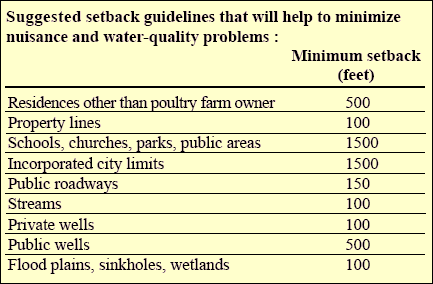



Site Selection Factors for new Poultry Facilities
By Charles Goan, Professor, Animal Science, University of Tennessee - Farmers considering building poultry facilities on their farms must give considerable thought to the location of the new structures.
Today, poultry farmers must be aware of concerns related to (1) environmental issues like water quality, odors and flies, litter applications on fields and high soil phosphorous levels; (2) nearby neighbors and public areas like churches, parks and businesses; and (3) laws and regulations that affect farming operations.
Future poultry farmers must place greater
emphasis on farmstead planning than has been done
in the past. Considerations in site selection for
buildings must include utilities, roads, topography,
prevailing winds, existing buildings, neighbors,
public areas, setbacks, and state and federal
government laws and regulations.
Neighbors – The location of nearby homes
should be the number one consideration when
evaluating potential locations for poultry facilities.
Good neighbors can quickly become enemies if the
building site is too close to nearby homes. Some
poultry companies require prospective poultry
farmers to discuss building plans with their neighbors
before construction starts. Even if discussions with
neighbors are not required, this practice is
recommended. Reaction from neighbors may force
alternate sites to be chosen.
Setbacks – How far should poultry houses be set
back from residences, property lines, public areas,
public roads, streams, wells, sinkholes and flood plains?

Currently, Tennessee does not have any laws or regulations that govern setbacks for agricultural building sites. However, most poultry industry companies have self-imposed setback guidelines that need to be considered. These guidelines will help reduce problems associated with odors, dust, feathers, noise and water quality.
Topography – Whether the site is level, gently
rolling or hilly will determine the amount of grade
work that must be done to get a level area for the
buildings. Grade work can add substantially to the
total construction cost. Avoid low-lying areas near
streams with flooding potential. Preferably, the
topography will allow the long axis of the poultry
house to be located in an east-west direction. This
helps to minimize the amount of direct sunlight that
would enter through the sidewalls of the houses.
Storm Water – Adequate drainage for storm
water control must be considered because of the large
amount of roof area. Storm water runoff should not
be allowed to create erosion problems around the
houses. Grass-covered water run-off ditches will help
reduce potential erosion problems. The immediate
area outside the buildings must have sufficient slope
to keep runoff water out of the buildings.
Prevailing Wind – Prevailing wind direction
must be considered when wind currents flow from
the chicken house toward any residence. Odors from
poultry houses must be given adequate time and
distance to dissipate before reaching a residence.
The distance from the poultry house location to any
residence would need to be greater if prevailing
winds were toward the residence. Since poultry
companies require mechanical ventilation in all
poultry houses; locating the poultry house to take
advantage of prevailing wind direction for natural
ventilation is no longer important.
Wind Shed – Wind shed is a term which describes
wind flow pattern on the downside of an existing
building (Figure 1). To help minimize complaints by
neighbors, strong consideration must be given to keep
nearby homes out of the windshed area.
Utilities – Some questions about utilities must be
answered to help determine building site location. Is
electricity readily available or will the local electric
utility run new lines at a reasonable cost? Is water
available from wells or a municipal water system or
both? It is important to have a backup water system.
Is the quality and quantity of the well water suitable
for a poultry operation? Is propane and/or natural gas
available at competitive prices?
Roads – The condition of public roads must be
adequate to allow feed trucks, chick- delivery
vehicles and live-haul trucks access to the buildings
during all times of the year. Are there any weight
limits or bridges that would restrict access to the
farm? How much will it cost to construct an access
road from the public road to the buildings? Can the
heavily loaded trucks travel easily on the access road
in all types of weather?
Future Expansion – Does the potential building
site allow the possibility for further expansion? Often
a poultry farmer will start with two houses and want
to build an additional two houses at a later time.
Other Buildings – The building site needs to
have adequate land area available for other
buildings, such as dead-bird composting and litter
storage. These buildings should be out of public
view if possible. The buildings need to be located
close enough to the production facilities to
minimize travel time, but far enough away to reduce
possible disease transmission. A distance of about
100 feet is a reasonable compromise.
Litter Utilization – Is there sufficient land
available on the farm to properly utilize the litter as
fertilizer, or will some of the litter be moved offsite?
Approximately 300 tons of litter will be produced each
year on a 50,000-bird capacity broiler farm. A nutrient
management plan will help determine if adequate land
area is available for litter utilization. If not, plans must
be made to remove excess litter offsite.
Summary
Proper siting of new poultry facilities is
extremely important. Problems can result if facilities
are built in unfavorable locations. The best time to
handle potential problems is BEFORE they occur.
Proper planning will help prevent environmental
problems from occurring, and will save time, money
and headaches in the long run.
Source: Agricultural Extension Service, University of Tennessee - September 2005









